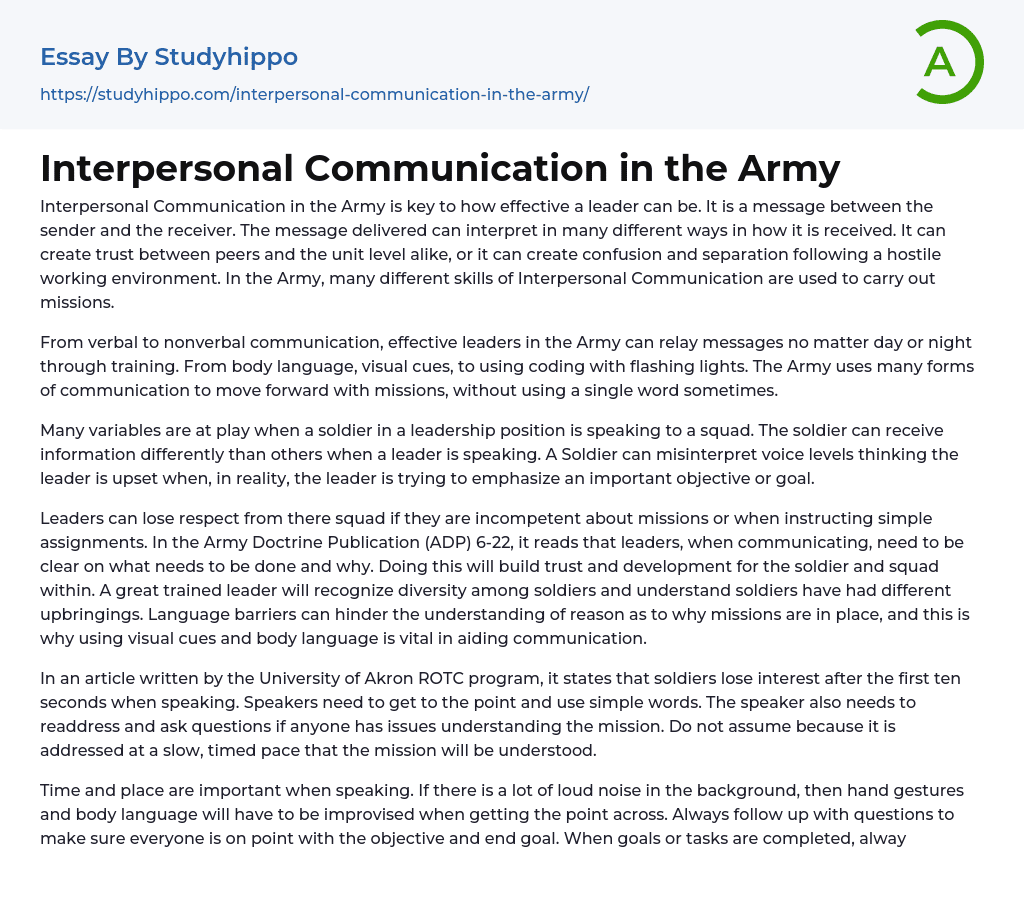Interpersonal Communication in the Army is key to how effective a leader can be. It is a message between the sender and the receiver. The message delivered can interpret in many different ways in how it is received. It can create trust between peers and the unit level alike, or it can create confusion and separation following a hostile working environment. In the Army, many different skills of Interpersonal Communication are used to carry out missions.
From verbal to nonverbal communication, effective leaders in the Army can relay messages no matter day or night through training. From body language, visual cues, to using coding with flashing lights. The Army uses many forms of communication to move forward with missions, without using a single word sometimes.
Many variables are at play when a soldier in a leadership position is speaking
...to a squad. The soldier can receive information differently than others when a leader is speaking. A Soldier can misinterpret voice levels thinking the leader is upset when, in reality, the leader is trying to emphasize an important objective or goal.
Leaders can lose respect from there squad if they are incompetent about missions or when instructing simple assignments. In the Army Doctrine Publication (ADP) 6-22, it reads that leaders, when communicating, need to be clear on what needs to be done and why. Doing this will build trust and development for the soldier and squad within. A great trained leader will recognize diversity among soldiers and understand soldiers have had different upbringings. Language barriers can hinder the understanding of reason as to why missions are in place, and this is why using visual cues and body language i
vital in aiding communication.
In an article written by the University of Akron ROTC program, it states that soldiers lose interest after the first ten seconds when speaking. Speakers need to get to the point and use simple words. The speaker also needs to readdress and ask questions if anyone has issues understanding the mission. Do not assume because it is addressed at a slow, timed pace that the mission will be understood.
Time and place are important when speaking. If there is a lot of loud noise in the background, then hand gestures and body language will have to be improvised when getting the point across. Always follow up with questions to make sure everyone is on point with the objective and end goal. When goals or tasks are completed, always follow up with After Action Review (AAR). It gives a great insight into how to be a better communicator and show your squad you are willing to correct deficiencies.
When speaking to a squad and addressing missions, make sure everyone is working as a team. A leader must notice when soldiers alienate themselves from the squad. Leadership must also notice when a soldier is bringing down morale within the unit. Pulling the soldier aside and being an active listener can open up trust and unity.
Depending on the situation, leadership can show soldiers resources or counseling to meet the soldier's needs. Sometimes a soldier is afraid to ask for help no matter how big or small the issue is. It can be something simple as going overhand visual signals for field exercises. Soldiers are nervous about asking a question during briefing, so it is important to follow
up on body language and eye contact.
Doing this can make leadership understand the soldier situation and, at the same time, make leadership approachable. Helping with morale, units can have family days or some type of team activity. Building morale within a unit can be as simple as recognizing a soldier for performance. Achievement awards or even sending the soldier to schools to promote can significantly increase morale. Doing this not only can boost morale but also retention as well.
In summary, Interpersonal Communication can build unity and trust among peers. Leadership recognizing their squad individual cultures and backgrounds can address communication accordingly. Using communication skills such as body language, gestures, and eye contact can help emphasize essential objectives within missions.
It is of great importance to make sure words are simple, concise, and to the point with communicating with soldiers. To be an effective leader, make sure to follow up with soldiers after mission objectives are put out. There is no point in dismissing the squad and assume they understand the mission. It is not all about presentations or going over maps anymore. Effective communication is an ongoing process, and like the old saying goes. The Army is all about repetitions.
References
- Command Sgt VanSciver, James (2017). Interpersonal Communication.
- Available at https://www.armyupress.army.mil/Journals/NCO-Journal/Archives/2017/October/Interpersonal-Communication/
- Army Doctrine Reference Publication 6-22, Army Leadership.




